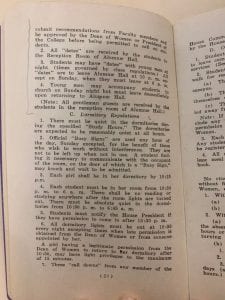My group decided to focus on the history of campus protest on James Madison University’s campus. We are going to cover not only the protests of the past, but how they have evolved over the years and include information about more recent protests.
The image above, taken from scrapbooks at JMU Special Collections, is of a Student Handbook. During the early conception of the University, regulations were strict for women attending the college. As shown above, all dates must be received in Alumnae Hall and lights in the dormitories were out at 10:30 p.m. Eventually, students became very dissatisfied with these strict regulations in 1941. In fact, the first formal protest of the student body at James Madison University was to oppose these strict rules and regulations they were forced to live under. This revolt would later become known as the “May Revolt.”
During this period, students were only allowed five minutes to walk from a dance with their dates back to their dormitories. Students were even monitored by members of the Student Council as this happened. That following Monday, after the May Dance had been held, students of the freshmen class gathered in Ashby (then the gym) and claimed they would stay there until there were significant changes made to the social regulations they were forced to abide by. Throughout the rest of the month of May, the freshmen threatened a sit-in, a hunger strike, a class boycott, and a march on Hillcrest (which was then the president’s residence).
Although none of these actions occurred, the students did succeed in securing changes made to the following: allowing them to spend more weekends off-campus, longer periods of time with lights on in the dormitories during final exams, freedom from wearing stockings on certain occasions, and compulsory attendance for certain campus events. Though not as radical as the 1970 protest, this first student protest did ultimately provide the students with more freedoms.


Recent Comments